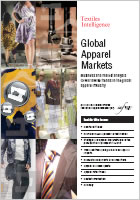Issue
10:
2nd Quarter 2010

Product Overview
Buy this Report now
Buy this Issue now
Subscribe
Download brochure (PDF)
Download price list (PDF)
Price list download
| Please choose your preferred currency:
|
Request sample issue
View list of reports
in other issues
|
Multi Report Package |
We also offer a flexible subscription product,
the Multi Report Package,
which allows you to select your own choice of reports from our full range,
to suit your own budget.
Click here for full details.
|
|
 |
Trade and trade policy: the US clothing import market, 2nd quarter 2010 |

17 pages,
published in Issue 10, 2nd Quarter 2010
Report price:
Euro 395.00;
US$ 520.00
|
US clothing imports fell in value by 5.6% to US$64.48 bn in the year ending May 31, 2010. In terms of volume, however, they were up by 1.9% to 22.35 bn sme. The average price of imports, meanwhile, fell by 7.4% to US$2.89 per sme.
The largest clothing supplying country during the year was China with a 38.2% share of the US clothing import market by value?up by 4.3 percentage points from a share of 33.9% a year earlier. In volume terms, China?s share grew by an even greater 5.6 percentage points, to 41.5%, as US imports from the country increased by 17.6%. China?s share of the US clothing import market has risen sharply since the elimination of safeguard restrictions at the end of 2008. This acted as a boost to trade at a time when imports from other countries were falling due to the global recession. Of the remaining top ten supplying countries, only Vietnam enjoyed growth in value and volume terms in the year ending May 31, 2010. However, the rise in value was minimal at just 0.5%. In volume terms imports were up by 8.7% although this reflected a 7.5% drop in the average import price. A similar pattern was witnessed in the case of imports from India and Indonesia. Although imports from each country fell slightly in value terms, they increased in volume reflecting a drop in their average import prices. The other suppliers among the top ten all performed disappointingly, having suffered falls in both value and volume. Having said that, most of the falls were confined to mid-single digits and were less severe than in the previous year. One notable exception was that of imports from Honduras, which fell at double digit rates in both value and volume terms.
China?s Ministry of Industry and Information Technology (MIIT) has initiated a rural subsidy programme to support the growth of the textile and garment industry. But the scheme could be a cause of friction for some US politicians. In another move, Chinese firms will have improved access to Hong Kong-based financial and legal services as part of the Closer Economic Partnership Agreement (CEPA). In Vietnam, Vietnamese and US officials have met to discuss ways of increasing bilateral trade and pave a wider path for increased business between the two countries. In Indonesia 200,000 jobs will be created as a result of the decision of nine Chinese textile and clothing companies to relocate their factories to central Java. In Bangladesh garment production costs could rise by 7% after the granting of an 80% hike in the minimum wage of garment workers. India is again on a list of countries ?possibly using child labour?. And US buyers of Honduran clothing are likely to be alarmed by a breakthrough in an eight-year-old dispute between Brazil and the USA concerning US cotton subsidies.
- Trade and trade policy: the US clothing import market
-
- Summary
- Introduction
- US clothing imports from China
- US clothing imports from Vietnam
- US clothing imports from Indonesia
- US clothing imports from Mexico
- US clothing imports from Bangladesh
- US clothing imports from India
- US clothing imports from Honduras
- US clothing imports from Cambodia
- US clothing imports from El Salvador
- US clothing imports from Pakistan
|
 |
